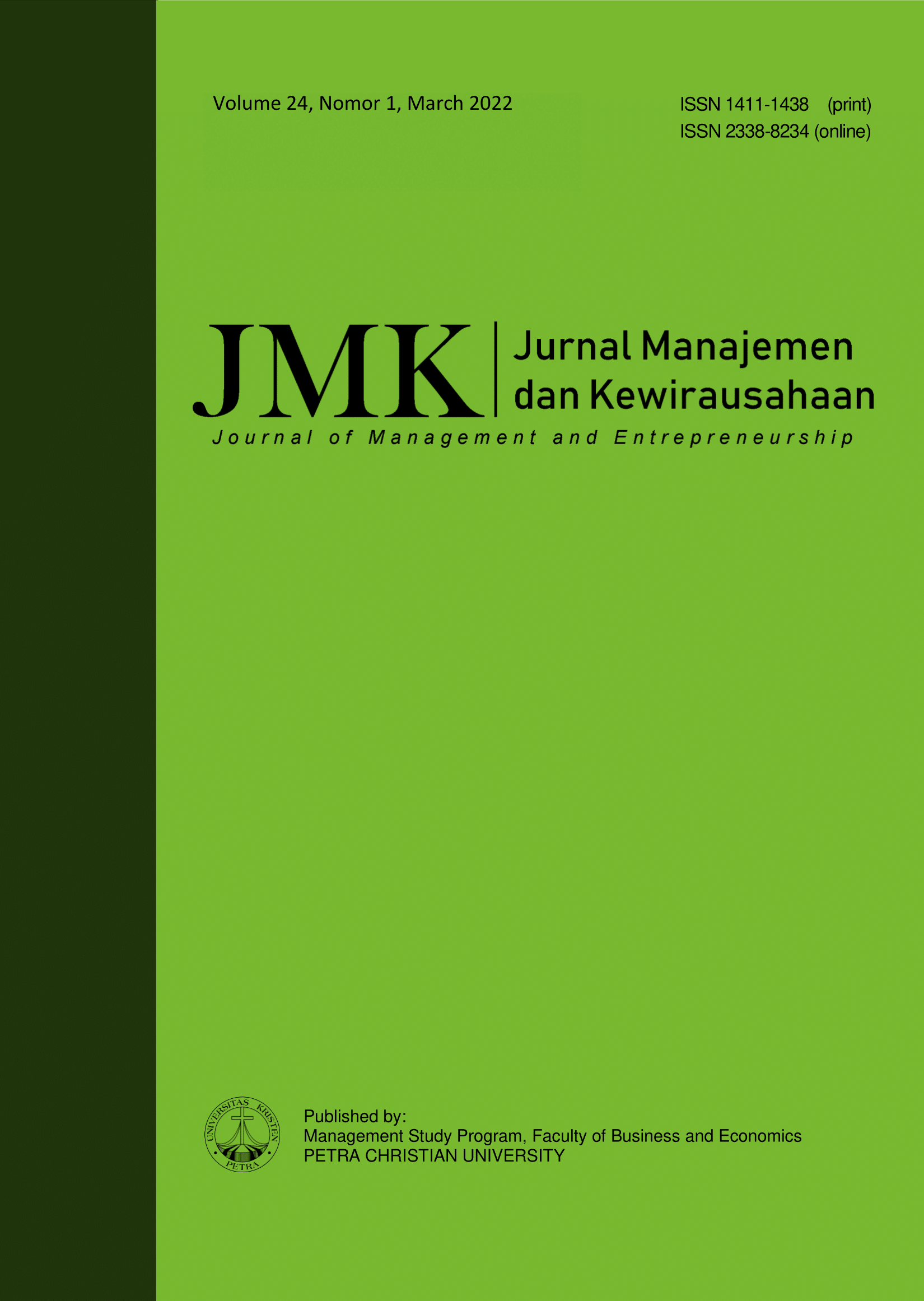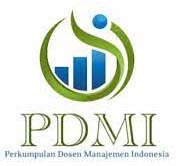SUCCESSFUL HR AUDIT: IS IT DETERMINED BY TOP MANAGEMENT COMMITMENT, HR CONSULTANTS, AND LINE MANAGER INVOLVEMENT
 :
:
https://doi.org/10.9744/jmk.24.1.33-43
Keywords:
Top management commitments, HR consultants, line manager involvement, HR auditAbstract
The research aimed to find out how to execute a successful HR audit by looking into the top management's commitment, HR consultants' function in the business, and the line manager's level of participation in the audit. 70% of the total population of employees who were selected using probability random sampling participated through an online questionnaire. The hypothesis was tested using structural equation modeling since a total of 104 respondents supplied favorable responses, but only 101 could be employed to test the hypothesis. The result showed that the absence of HR and line managers did not affect the success of HR audits from the starting point and that the term "audit" had a negative connotation.
References
Akay, E., & Demirel, A. G. (2018). Transformational leadership and innovation: An empirical study of direct and indirect effects in HR consulting com-panies. International Journal of Business and Management, 13(1), 131–142. https://doi.org/10. 5539/ijbm.v13n1p131
Andrews, C. (2017). Fundamental issues with HR auditing. HR Examiner. Retrieved from: https:// pure.bond.edu.au/ws/portalfiles/portal/2330707 9/Fundamental_Issues_with_HR_Auditing_22_May_2017.pdf
Astroth, K. S., & Chung, S. Y. (2018). Focusing on the fundamentals: Reading quantitative research with a critical eye. Nephrology Nursing Journal: Jour-nal of the American Nephrology Nurses’ Associa-tion, 45(3), 283–286.
Belout, A., & Gauvreau, C. (2004). Factors influencing project success: The impact of human resource management. International Journal of Project Management, 22(1), 1–11. https://doi.org/10.1016/S0263-7863(03)00003-6
Bieliaieva, N. (2019). International practice of the concepts use of “HR audit”, “staff audit”, “personnel audit.” Економіка. Екологія. Соціум, Т.3, T., 3(3), 94–101. https://doi.org/DОI:10.315 20/2616-7107/2019.3.3-11
Bieliaieva, N. (2019b). Development of the human resource audit system elements based on international experience. Economics. Ecology. Socium, 3(4), 28–34. https://doi.org/10.31520/2616-7107/ 2019.3.4-4
Bowers, A. J. (2017). Quantitative research methods training in education leadership and administration preparation programs as disciplined inquiry for building school improvement capacity. Journal of Research on Leadership Education, 12(1), 72–96. https://doi.org/10.1177/1942775116659 462
Bukhari, S. A. R. (2021). A new approach towards HR audit: Strengthening human resource department in Pakistan. Asian Journal of HRM, August, 1–13. https://doi.org/10.13140/RG. 2.2.18655.180 84
Cannings, A., & Hills, T. (2012). A framework for auditing HR: Strengthening the role of HR in the organisation. Industrial and Commercial Training, 44(3), 139–149. https://doi.org/10.1108/001 97851211216745
Chang, K. chung, Sheu, T. S., Klein, G., & Jiang, J. J. (2010). User commitment and collaboration: Motivational antecedents and project performance. Information and Software Technology, 52(6), 672–679. https://doi.org/10.1016/j.infsof.2010.0 2.003
Chin, W. W. (1998). The partial least squares approach to structural equation modeling. In G. A. Mar-coulides (Ed.), Modern methods for business research (pp. 295-336). Mahwah, NJ: Lawrence Erlbaum Associates.
Digalwar, A. K., Tagalpallewar, A. R., & Sunnapwar, V. K. (2013). Green manufacturing performance measures: An empirical investigation from Indian manufacturing industries. Measuring Business Excellence, 17(4), 59–75. https://doi.org/10.110 8/MBE-09-2012-0 046
Etikan, I., & Bala, K. (2017). Sampling and sampling methods. Biometrics & Biostatistics International Journal, 5(6), 215–217. https://doi.org/10. 15406/bbij.2017.05.00149
Graves, L. M., Sarkis, J., & Gold, N. (2019). Employee proenvironmental behavior in Russia: The roles of top management commitment, managerial leadership, and employee motives. Resources, Conservation and Recycling, 140, 54–64. https://doi.org/10.1016/j.resconrec.2018.09.007
Hair, J. F., Black, W. C., Babin, B. J., & Anderson, R. E. (2010). Multivariate data analysis (7th ed.). Pearson Prentice Hall.
Hair, J. F., Ringle, C. M., & Sarstedt, M. (2011). PLS-SEM: Indeed a silver bullet. Journal of Marketing Theory and Practice, 19(2), 139–152. https://doi. org/10.2753/MTP1069-6679190202
Keegan, A., Huemann, M., & Turner, J. R. (2012). Beyond the line: Exploring the HRM responsibilities of line managers, project managers and the HRM department in four project-oriented companies in the Netherlands, Austria, the UK and the USA. International Journal of Human Resource Management, 23(15), 3085–3104. https://doi.org/10.1080/09585192.2011.610937
King, D. R., Bauer, F., Weng, Q., Schriber, S., & Tarba, S. (2020). What, when, and who: Manager involvement in predicting employee resistance to acquisition integration. Human Resource Mana-gement, 59(1), 63–81. https://doi.org/10.1002/hr m.21973
Kissi, J., Dainty, A., & Tuuli, M. (2013). Examining the role of transformational leadership of portfolio managers in project performance. International Journal of Project Management, 31(4), 485–497. https://doi.org/10.1016/j.ijproman. 2012.09.004
Kitsis, A. M., & Chen, I. J. (2021). Do stakeholder pressures influence green supply chain Practices? Exploring the mediating role of top management commitment. Journal of Cleaner Production, 316(June), 128258. https://doi.org/10.1016/j. jclepro.2021.128258
Korneliusson, M., & Mohammadi, P. (2018). A lean transformation journey focusing on leadership-For first line managers. Retrived from: https:// odr.chalmers.se/ handle/20.500.12380/255694
Kotamena, F., Senjaya, P., Putri, R. S., & Andika, C. B. (2020). Competence or commu¬nica¬tion: From HR professionals to employee performance via employee satisfaction. Jurnal Manajemen dan Kewirausahaan, 22(1), 33–44. https://doi.org/10. 9744/22.1.33
Kulchitskaya, E. V., Rodionova, E. A., Penzina, O. S., Maslova, E. V., & Kizyan, N. G. (2016). Cogni-tive and motivational aspects of HR audit implementation in an organization. Indian Journal of Science and Technology, 9(40), 1–7. https://doi. org/10.17485/ijst/2016/v9i40/100298
Liao, H., & Chuang, A. (2004). A multilevel inves-tigation of factors influencing employee service performance and customer outcomes. Academy of Management Journal, 47(1), 41–58. https://doi.org/10.2307/20159559
López-Cotarelo, J. (2018). Line managers and HRM: A managerial discretion perspective. Human Re-source Management Journal, 28(2), 255–271. https://doi.org/10.1111/1748-8583.12176
Malik, R. (2018). An assessment of effectiveness of HR audit in automobile industries of Haryana by analysis of dependency between factors. Turkish Journal of Physiotherapy and Rehabilitation, 32(2), 3664–3673.
Mansor, N. N. A., Saidi, M. I., Mohamed, A., & Idris, N. (2012). Organizational factors in learning and development initiatives. Procedia - Social and Behavioral Sciences, 40, 565–570. https:// doi.org/10.1016/j.sbspro.2012.03.231
Margerison, C. J. (2018). Managerial consulting skills - A practical guide. Second Edition. New York, NY: Routledge.
Mishra, S. S., Kunte, M., Neelam, N., Bhattacharya, S., & Mulay, P. (2021). HR process automation: A bibliometric analysis. Library Philosophy and Practice, 2021. Retrieved from: https://www. proquest.com/openview/854330c262eca9554eff8f5d69514a5d/1?pq-origsite=gscholar&cbl=54903
Mohd Thas Thaker, H., Khaliq, A., Ah Mand, A., Iqbal Hussain, H., Mohd Thas Thaker, M. A. Bin, & Allah Pitchay, A. Bin. (2021). Exploring the drivers of social media marketing in Malaysian Islamic banks: An analysis via smart PLS approach. Journal of Islamic Marketing, 12(1), 145–165. https://doi.org/10.1108/JIMA-05-2019-0095
Njogu, V. J., & Simiyu, A. (2019). Influence of management commitment on implementation of e-learning projects in public universities in Kenya. International Journal of Research in Business, Economics and Management, 3(2), 70–85.
Poorani, T., & Thiyagarajan, S. (2018). Assessing value creation of HR consultants on e-consulting implementation. Technology in Society, 55, 160–165. https://doi.org/10.1016/j.techsoc.2018.07. 008
Renwick, D. (2003). Line manager involvement in HRM: An inside view. Employee Relations, 25 (3), 262–280. https://doi.org/10.1108/01425450 310475856
Rimi, N. N., Yusliza, M. Y., Walters, T., & Basher Rubel, M. R. (2017). The role of devolution in HR-line manager collaboration and HRM effectiveness relationship: A study of private comercial banks in Bangladesh. Global Business and Organizational Excellence, 36(4), 43–51. https://doi.org/10.1002/joe.21789
Rouf, M. A., & Akhtaruddin, M. (2018). Factors affecting the voluntary disclosure: A study by using smart PLS-SEM approach. International Journal of Law and Management, 60(6), 1498–1508. https://doi.org/10.1108/IJLMA-01-2018-0011
Samman, A. M. Al. (2017). Construction industry and hr audit could it support the organizational objectives and strategies? A case study from the egyptian market. European Journal of Business and Management, 9(6), 44–57. Retrieved from: https://core.ac.uk/download/pdf/234627746.pdf
Sarstedt, M., Ringle, C. M., Smith, D., Reams, R., & Hair, J. F. (2014). Partial least squares structural equation modeling (PLS-SEM): A useful tool for family business researchers. Journal of Family Business Strategy, 5(1), 105–115. https://doi.org/ 10.1016/j.jfbs.2014.01.002
Savaneviciene, A., & Stankeviciute, Z. (2011). The interaction between top management and line managers implementing strategic directions into praxis. Engineering Economics, 22(4), 412–422. https://doi.org/10.5755/j01.ee.22.4.716
Šiugždinienė, J. (2008). Line manager involvement in human resource development. Viešoji Politika Ir Administravimas, 25, 32–37.
Tarigan, Z. J. H., Siagian, H., & Jie, F. (2020). The role of top management commitment to enhancing the competitive advantage through ERP integration and purchasing strategy. International Journal of Enterprise Information Systems, 16(1), 53–68. https://doi.org/10.4018/IJEIS.2020010103
Ting, S. H., Yahya, S., & Tan, C. L. (2020). Importance-performance matrix analysis of the researcher’s competence in the formation of university-industry collaboration using Smart PLS. Public Organization Review, 20(2), 249–275. https://doi.org/10.1007/s11115-018-00435-z
Ukil, M. I. (2015). Essence of human resource audit: an analytical study. Journal of Management and Science, 1(1), 101–110. https://doi.org/10.26524/ jms.2015.10
Vasantham, S. T. (2021). Importance of HR audit. International Journal of Management, 11(11), 2516–2520. https://doi.org/10.34218/IJM.11.11. 2020.235
Vivas Martin, J. G., & Perez Gonzalez, J. F. (2019). Study of technological monitoring in information systems audit in Colombia. 2019 Congreso Internacional de Innovacion y Ten¬dencias En Ingenieria, CONIITI, 2019, pp. 1–6. https://doi.org/10.1109/CONIITI48476. 2019.8960702
Wong, K. K. K.-K. (2013). Partial least squares struc-tural equation modeling (PLS-SEM) techniques using SmartPLS. Marketing Bulletin, 24(1), 1–32.
Yusliza, M. Y., Norazmi, N. A., Jabbour, C. J. C., Fernando, Y., Fawehinmi, O., & Seles, B. M. R. P. (2019). Top management commitment, corpo-rate social responsibility and green human resource management: A Malaysian study. Benchmarking, 26(6), 2051–2078. https://doi.org/10.1 108/BIJ-09-2018-0283
Zyphur, M. J., & Pierides, D. C. (2020). Making quantitative research work: From positivist dogma to actual social scientific inquiry. Journal of Business Ethics, 167(1), 49–62. https://doi.org /10.1007/s10551-019-04189-6
Downloads
Published
How to Cite
Issue
Section
License
Authors who publish on this journal agree to the following terms:
- Authors retain copyright and grant the journal right of first publication with the work simultaneously licensed under a Creative Commons Attribution License that allows others to share the work with an acknowledgement of the work's authorship and initial publication in this journal.
- Authors are able to enter into separate, additional contractual arrangements for the non-exclusive distribution of the journal's published version of the work (e.g., post it to an institutional repository or publish it in a book), with an acknowledgement of its initial publication in this journal.
- Authors are permitted and encouraged to post their work online (e.g., in institutional repositories or on their website) prior to and during the submission process, as it can lead to productive exchanges, as well as earlier and greater citation of published work (See The Effect of Open Access).


















